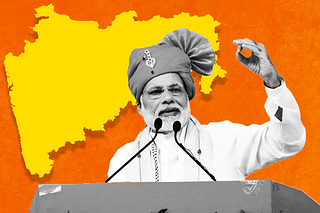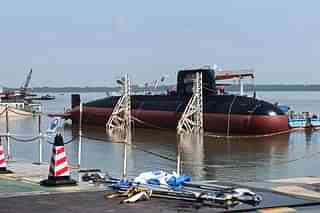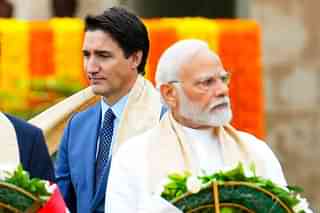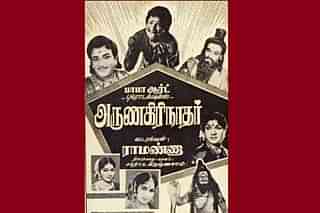Culture
‘Can’t Ask For Anything More’ - Says Prakash Ilaiyaraja Who Played The Nadaswaram At Ram Mandir Pran Pratishtha
Ranjani Govind
Jan 28, 2024, 06:48 PM | Updated 06:48 PM IST
Save & read from anywhere!
Bookmark stories for easy access on any device or the Swarajya app.
Although nadaswaram isn’t easy to play as it demands lung power, its inherent loud volume too adds to a student’s woes to practice in crowded localities. But its enduring force has been strong as the instrument considered a ‘Mangala Vadya’ (sacred instrument) is a hardy survivor both in traditional renderings and on classical platforms.
“There are no dearth of players in South India owing to its divine-connect and the pious ambience it emanates in any sacred event. But a re-consideration by nadaswara players to embrace hardcore paddhati (tradition) would help the instrument’s permanence, is what the Nadaswara vidwans taking across a lineage feel,”says Nadaswara artiste V. Prakash Ilaiyaraja, a Tiruvarur-based artiste, and professor at Government Music College in Tiruvarur.
Prakash Ilaiyaraja is the fourth generation of musicians in his family of thavil and nadaswara artistes from Idumbavanam in Tiruvarur district of Tamil Nadu.
Senior nadaswaram players do not believe in the young taking to the instrument as a seasonal fad, or trends like ensembles and fusions to decide the future of the instrument. “Nadaswara’s dignity is in its time-honoured, orthodox engagement with temple and classical events,” says Prakash, born to KS Vethamoorthi a nadaswara player, and Gnanasundari in 1981.
Music has been nucleus to the family, a part of the growing-up psyche for Prakash who was groomed by his father. “Segal G Ranganathan was my first official guru in nadaswara as I needed a formal direction. So I had a devout schooling in gurukulavasa from my guru at Idumbavanam where I grew up,” says Prakash.
Prakash’s formal lessons began when he was nine, and by 11, had his first performance in a temple. From then on there has been no looking back. Apart from the popular music seasons all over India, his overseas performance includes the Cleveland Festival in the US, some temple events and concerts in the UK, Malaysia, Singapore and Sri Lanka.
V. Prakash Ilaiyaraja spoke to Swarajya on his life-time experience at Ayodhya, his growing up years in melody and his efforts to preserve the conventional background associated with the instrument.
Edited excerpts:
How did Ayodhya participation happen?
After receiving the ‘2020 Sangeet Natak Akademi Yuva Puraskar Award’ I was in touch with the Akademi that helps awardees participate in concerts.The Akademi approached me to take part in the Ayodhya Ram Lalla consecration ceremony and my 9-year old son Kavin Prakash accompanied me on nadaswaram along with thavil artistes.
Earlier the Sangeet Natak Akademi had brought together 75 musician awardees for an ensemble for G-20 Summit. I was amongst the 75 awardees to present ‘Bharat Vadyothsav’ at G-20 Summit at Pragati Maidan in New Delhi. Generally it’s been a practice to have Akademi Awardees perform at important government functions as a mark of recognising their vidwat.
How did you feel performing at Ayodhya?
Thanks to Sangeet Natak Akademi, it was my fortune to perform at Ayodhya. Another grace was my 9-year old son Kavin, a 4th standard student’s incidental accompaniment. Both of us feel truly blessed by Ram Lalla.
We played for two hours. We the five nadaswaram and thavil players, and five other shehnai players were part of the presentation inside (even as the pandits concurrently carried out the pooja rituals along with PM Modi) that thousands of people got to hear from outside.
Being part of the melodic scene itself felt like a life-time achievement! Although it’s not fully sunk in, I feel after this ultimate Ayodhya reality, I have nothing more to ask for! It was a life fulfilling moment. As we were part of the special set of musicians for the ceremonial occasion, we had exclusive darshan of Lord Ram Lalla to soak in the energy and positive vibes.
What made up your packaging?
We flagged off with ‘Vatapi Ganapathim’ in Hamsadwani followed by the Pancharatna of Tyagaraja ‘Endaro Mahanubhavulu,’ ‘Ramabhakthi Saamrajyam’ in Shuddabangala; ‘Sujanajeevana’ in Kamas and a Tamil kriti ‘Kurai Onrum Illai’ for Aarati.
We took to Mallari as the PM entered the environs and as he walked in for the pooja, we played ‘Raghupathi Raghava Rajaram.’
You are into a family of nadaswaram players
My forefathers were basically Thavil players with abundant knowledge of nadaswaram playing. But my father changed gears to lap up the nadaswaram completely and he mastered the instrument.
I took it up when I was 9. My deep observations of the nadaswaram scene over the years helped me work towards preserving temple traditions that I observe are gradually fading away.
Although the temple sampradaya, intrinsically related with nadaswaram play, is active in many places of worship, especially in Chidambaram temples, I am apprehensive that it’s not anymore elaborate and extended with the required depth and feel. We require a follow up of traditional packaging in presentations.
Your efforts to see the temple traditions thrive
The nadaswaram playing traditions in temple rituals include the Mallari, amongst others, for deity processions - comprised solely of rhythmical thavil syllables structured to be rendered in several speeds. In a 10-day temple utsav, there are particular ragas to be used each day with elaborate raga-alapane and neraval and swaras and specific songs or styles rendered as the procession proceeds in each lane of the temple town.
I have paired up with Nadaswara vidwan Chinnamanur A. Vijaikarthikeyan (professor in Annamalai University) who belongs to the Tirupampuram tradition which mirrors a 9-generation styling of nadaswara-play. Our mentor is Kalaimamani NG Ganeshan who has studied the temple traditions with nadaswara. His guidance is helping us both steer an approach to re-discover the forgotten melodic path in temple sampradaya. Our lec-dems and concerts help understand the paddhati or the root and lineage involved in traditional play at temples.
What is your family styling, how does it differ from other styles?
Ragamalika concept in nadaswaram is unique to our school of play, and we are popularizing this not just in concerts but as a ritualistic convention. We are fastidious about a few melodic arrangements followed.
For example, when the Utsava gets over and the deity is being brought in, the pace and stride that involves taking measured steps are meticulously represented with many a raga.
I remember in Tiruvendipuram when the sacred procession is in its final lap before the procession enters the sanctum-sanctorum, nearly 60 ragas each lasting a few seconds are covered. These are all dear to our family traditions in music.
Your son is the fifth generation of musicians in your family?
Kavin took to the instrument naturally, with no force from anyone.
When we heard him play the initial lessons of alankara and geete we came to know that he was inclined towards playing on the instrument.
Often when we all went out, he would take my nadaswaram and with my father’s guidance practice on the instrument.
One day, as I was entering home I was surprised to hear a different melody, and was taken aback to see my son wield the instrument, playing the alankara!! That set the beginning, and I intervened and helped him strengthen his foundation with nuances that could reinforce aspects for performing.
How is the nadaswaram scene now?
If we look back two decades or so, the booming education scene and the job opportunities shook every musician’s future who preferred a vocation in melody.
Today, globalisation, art festivals that bring in musical exchanges, ambassadors and organisers of music curating newer experimentations, western orchestras and Indian music fusions and our own people realising the traditional value of the nadaswaram, has flipped the scene to see positive changes.
Take my own example as a teacher - I have nearly 50 students and 20 per cent are foreigners among them, and my online classes go on regularly. Many of my foreign students are performers too! A student from the US, who came to me for vocal lessons loving Indian music, was magnetically attracted towards the booming nadaswara and her passion has her on platforms now. It’s the same case with nearly half-a-dozen students in the UK!
Save & read from anywhere!
Bookmark stories for easy access on any device or the Swarajya app.
Introducing ElectionsHQ + 50 Ground Reports Project
The 2024 elections might seem easy to guess, but there are some important questions that shouldn't be missed.
Do freebies still sway voters? Do people prioritise infrastructure when voting? How will Punjab vote?
The answers to these questions provide great insights into where we, as a country, are headed in the years to come.
Swarajya is starting a project with an aim to do 50 solid ground stories and a smart commentary service on WhatsApp, a one-of-a-kind. We'd love your support during this election season.
Click below to contribute.





